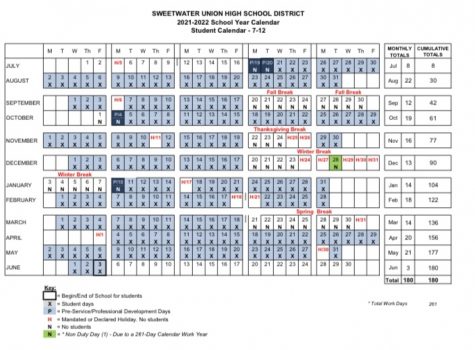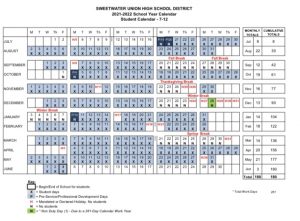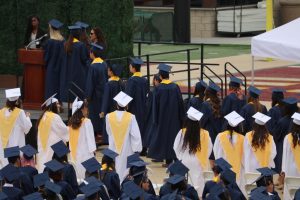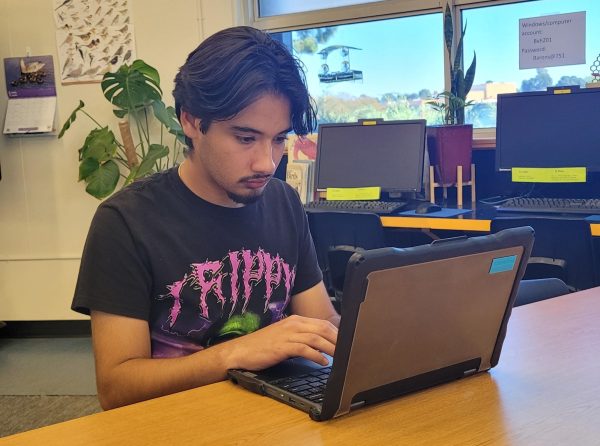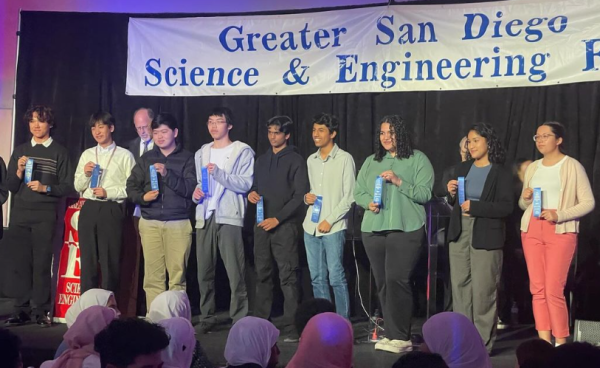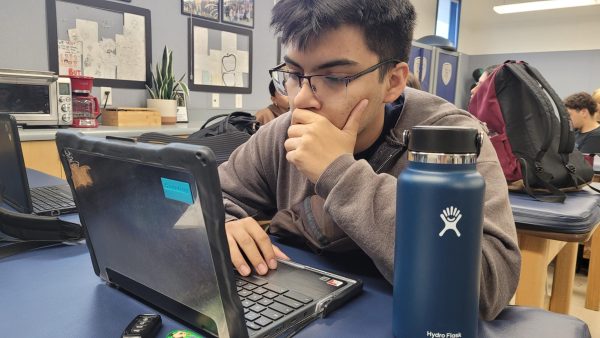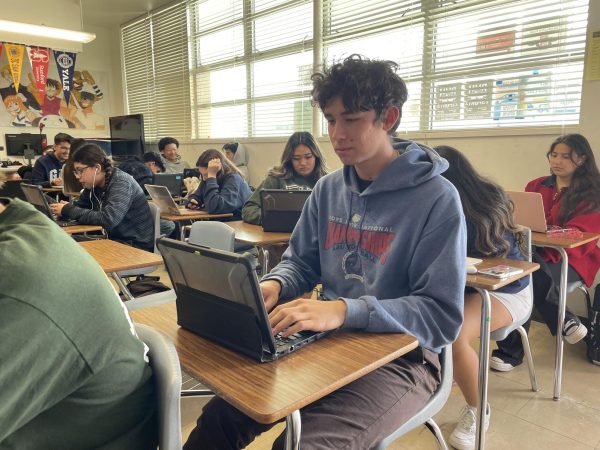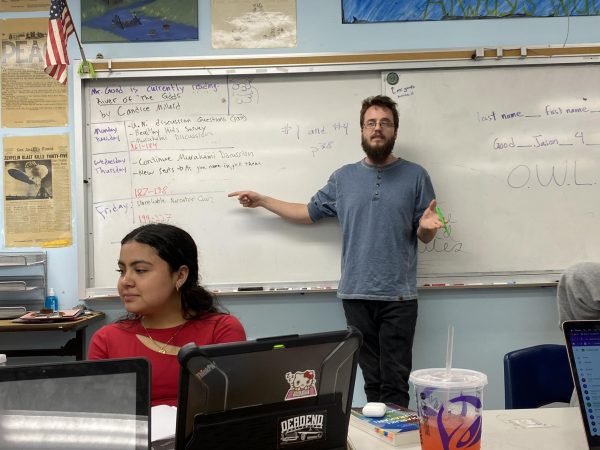The first lesson on campus: How teachers transitioned to in-person instruction
On the week of April 12, 10 percent of Bonita Vista High (BVH) students, teachers and staff began going back to the mostly empty campus for in-person school, starting a hybrid schedule. Students walk down the deserted hallways of BVH, following the taped arrows on the floor directing them to their classrooms.
As masked students walk into their classrooms, they are greeted by their teacher along with an interactive flat-screen purchased by the BVH administration. In preparation for hybrid learning, BVH teachers received training to ensure safe, socially distant learning in classrooms for returning students.

Advanced Placement (AP) Environmental Science teacher Adrienne Marriott, one of the returning teachers, explained that she was happy to volunteer to return to campus because she didn’t have to worry about childcare or parent responsibilities like other teachers would in returning to in-person learning.
“I was ready for a little bit of change in my day and I thought that [because] we’re starting with a really small number of students, it would be easy to practice the safety policies of social distancing and masking,” Marriott said.
Marriott added that SUHSD’s return plan was effective and kept safety protocols in place. All students and teachers must wear their masks the entire time, maintain six feet of distance, and follow the signs that were present to direct the flow of students in the hallways in an effort to minimize crowding. Human Geography and Peer Counseling teacher Laura Lowery also came back to campus for similar reasons to Marriott.
“After thinking about it, I realized [that] changing my work environment and having the opportunity to interact with students in-person would be worth the adjustment; I was quite excited to come back,” Lowery said.
Lowery agreed with Marriott, saying it was effective to start with a small percentage of returning students. However, Lowery hopes to see more students soon and believes that BVH can still maintain all the necessary precautions with additional students on campus. Both Lowery and Marriott mentioned that although they were glad to have come back, transitioning into hybrid learning requires time to fully adjust to this new way of teaching.
“[Teaching both online and in-person] is a little awkward. I have struggled […] with thinking about who I am trying to look at and make eye contact with the people through the Zoom or the people in my room,” Marriott said.
AP English Language, English 11 and English 12 Rhetoric and Writing teacher Brian Bane also faced challenges in his teaching due to the switch to hybrid learning. He explained the challenges that come with sitting in the same room with students during online synchronous time.
“Because of technology [microphone and feedback issues], it is challenging for students who are physically in the classroom to speak during the live sessions when they might otherwise be able to if in a different room,” Bane said.
According to Bane, he also struggled in keeping his students engaged during in-person class activities because only a limited number of students were allowed to be back on campus, making communication more difficult.
“With fewer than five students in a class, it can put too much pressure on a student when they don’t have other students to communicate with face-to-face as well as added pressure to be the only one to answer a question once the online class is over,” Bane said.
Marriott discussed the benefits she and her students on campus receive once asynchronous time begins, saying it helped her feel like “a good supportive teacher.” She appreciated being available to students who might need help on asynchronous work, which online students don’t get as much of. Similarly, Lowery also enjoyed being on campus with her students.
“I enjoy when the asynchronous time begins [because] I can give one-on-one attention to students in the classroom. I’m able to individually help them, chat with them, get to know them as well as keep them focused and on task by checking their progress periodically,” Lowery said.
Lowery not only pointed out the academic benefits but also mentioned the social interactions she’s missed having with her students while teaching on campus, especially with her freshman students who haven’t attended BVH in person yet.
Seeing students has been the best part of returning. It’s nice to finally put a face and personality to a name.
— Human Geography and Peer Counseling teacher Laura Lowery
“Seeing students has been the best part of returning. It’s nice to finally put a face and personality to a name. I’ve enjoyed the small talk with students in class that doesn’t happen online,” Lowery said.
Marriott also missed the social aspect of in-person learning and described how isolating it has been for everyone to not be able to socialize with friends and classmates. Especially because students are used to learning in more social environments.
“It’s good to see people, and even during lunch, seeing students acting like students. I’m glad to be able to see some of my teacher buddies around campus and just have some of that chit-chat that’s been missing,” Marriott said.
Marriott added that she is able to enjoy on-campus learning because she felt safe and comfortable with the safety plan and training BVH set in place for teachers. Teachers completed a 90-minute training module including a PowerPoint, video and questions regarding COVID-19 safety protocols and sanitizing procedures. Teachers also spent two hours learning about the new system of colored dots used to differentiate between the desks, so each period has a new set of desks for the safety of the students.
“[The training] was more than adequate to prepare for having students back in class. I felt like the school and [the] district had done a good job of thinking through all of the safety issues and had a good plan,” Marriott said.
Overall, Bane believes that BVH needs to go back to on-campus teaching “as soon as possible” because it will benefit students who don’t have a good working environment at home or that need extra help in their classes. Nonetheless, he agreed with Marriott and Lowery in his excitement to have some students back on campus.
“I’d encourage students to return to campus if or when they have the opportunity to, especially [the] freshman students who haven’t had the chance to get familiar with the campus yet,” Lowery said.

Hi! I’m a junior at BVH and this is my second year on the Crusader staff. My position this year is staff artist, which means I get to make graphics and...

I’m a senior at Bonita Vista High and a second year staff member. I love to take photos of scenery and events all around me and I find that taking photos...

